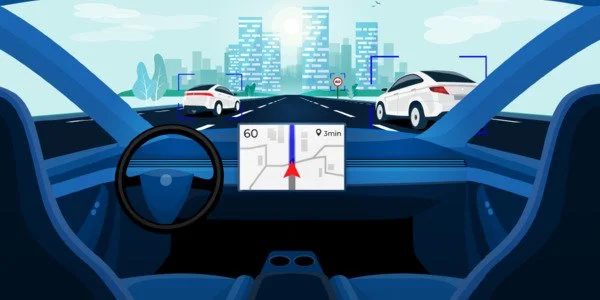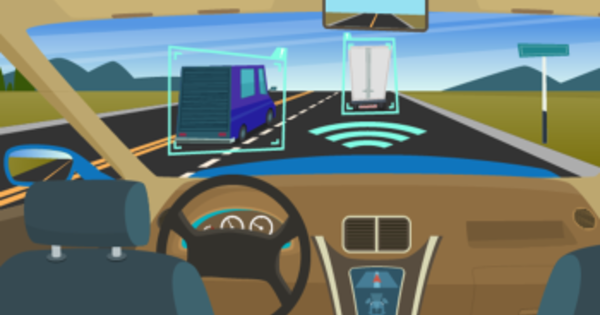According to a new study from the University of Tokyo, robotic eyes on autonomous vehicles could improve pedestrian safety. Participants acted out scenarios in virtual reality (VR), deciding whether or not to cross a road in front of a moving vehicle. Participants were able to make safer or more efficient choices when that vehicle was outfitted with robotic eyes that either looked at the pedestrian (registering their presence) or away (not registering their presence).
Self-driving cars appear to be on the horizon. Whether they’ll be delivering packages, plowing fields, or transporting children to school, a lot of research is being conducted to make a once-futuristic idea a reality.
While many people are concerned about the practical aspects of developing vehicles that can navigate the world autonomously, researchers at the University of Tokyo have turned their attention to a more “human” aspect of self-driving technology. “There hasn’t been enough research into the interactions between self-driving cars and their surroundings, such as pedestrians. As a result, more research and effort must be put into such interactions in order to provide society with safety and assurance regarding self-driving cars” Professor Takeo Igarashi of the Graduate School of Information Science and Technology stated this.
In this study, we focused on the movement of the eyes but did not pay too much attention to their visual design. We just built the simplest one to reduce the cost of design and construction due to budget constraints.
Professor Takeo Igarashi
One significant difference with self-driving vehicles is that drivers may become more of a passenger, so they may not be paying full attention to the road, or there may be no one at the wheel at all. This makes it difficult for pedestrians to determine whether a vehicle has registered their presence or not, as there may be no eye contact or indications from the people inside.
So, how could pedestrians be alerted when an autonomous vehicle has detected them and intends to stop? A self-driving golf cart was outfitted with two large, remote-controlled robotic eyes, similar to a character in the Pixar film Cars. The researchers dubbed it the “gazing car.” They wanted to test whether putting moving eyes on the cart would affect people’s more risky behavior, in this case, whether people would still cross the road in front of a moving vehicle when in a hurry.
The team set up four scenarios, two where the cart had eyes and two without. The cart had either noticed the pedestrian and was intending to stop or had not noticed them and was going to keep driving. When the cart had eyes, the eyes would either be looking towards the pedestrian (going to stop) or looking away (not going to stop).

As it would obviously be dangerous to ask volunteers to choose whether or not to walk in front of a moving vehicle in real life (though for this experiment there was a hidden driver), the team recorded the scenarios using 360-degree video cameras and the 18 participants (nine women and nine men, aged 18-49 years, all Japanese) played through the experiment in VR. They experienced the scenarios multiple times in random order and were given three seconds each time to decide whether or not they would cross the road in front of the cart. The researchers recorded their choices and measured the error rates of their decisions, that is, how often they chose to stop when they could have crossed and how often they crossed when they should have waited.
“The results suggested a clear difference between genders, which was very surprising and unexpected,” said Project Lecturer Chia-Ming Chang, a member of the research team. “While other factors like age and background might have also influenced the participants’ reactions, we believe this is an important point, as it shows that different road users may have different behaviors and needs, that require different communication ways in our future self-driving world.
“The male participants in this study made many dangerous road-crossing decisions (for example, choosing to cross when the car was not stopping), but the cart’s eye gaze reduced these errors. However, there was little difference between them in save situations (for example, choosing to cross when the car was about to stop) “Chang elaborated. “Female participants, on the other hand, made more inefficient decisions (for example, choosing not to cross when the car was about to stop), and these errors were reduced by the cart’s eye gaze. However, there was little difference between them in dangerous situations.” The experiment concluded that using the eyes resulted in a smoother or safer crossing for everyone.
But how did the participants react to the eyes? Some thought they were adorable, while others thought they were creepy or scary. Many male participants reported that when their eyes were turned away, they felt the situation became more dangerous. Many female participants said they felt safer when the eyes looked at them.
“In this study, we focused on the movement of the eyes but did not pay too much attention to their visual design. We just built the simplest one to reduce the cost of design and construction due to budget constraints,” Igarashi explained. “In the future, having a professional product designer find the best design would be preferable, but it would still be difficult to please everyone. I personally like it. It is kind of cute.”















